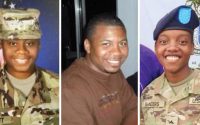Dick Traum, 83, Dies; Marathoner Championed Disabled Athletes
Dick Traum, who was regarded as the first person to run a marathon on a prosthetic leg, finishing New York’s race in 1976, and who went on to found the Achilles Track Club to encourage other disabled athletes in an era when they faced barriers to participation in sports, died on Jan. 23 in Manhattan. He was 83.
His death, at a rehabilitation facility after a heart attack, was confirmed by his wife, Elizabeth Traum.
Mr. Traum entered the New York City Marathon the first year the race expanded to all five boroughs, in the early flush of the 1970s jogging boom. There were about 2,000 runners, and Mr. Traum, whose right leg had been amputated above the knee, was one of just two with a disability. Given a four-hour head start, he was passed at mile 18 by the eventual winner, Bill Rodgers, who shouted, “Attaboy, Dick!”
Mr. Traum went on to race in more than 70 marathons, at first on his artificial leg and later by cranking a handcycle, a low, three-wheeled bike powered by his arms. In 1993, using forearm crutches, he jogged with President Bill Clinton in Washington.
The Achilles Track Club, which he founded in 1983 and led for 36 years, expanded to 18 countries, providing free training advice and psychological support. Now named Achilles International, the organization says 150,000 people have participated in its programs. In November, nearly 500 disabled athletes and guides raced in the latest New York City Marathon, many in the club’s neon yellow T-shirts.
“When an able-bodied runner gets passed by someone on one leg, it changes their perception of what the disabled can do,” Mr. Traum told CNN in 2012. “It also changes the way disabled athletes perceive themselves.”
A member of the New York Road Runners Hall of Fame, Mr. Traum persuaded its founder, Fred Lebow — who created the New York City Marathon — to sponsor the Achilles Track Club. At first, they tried to attract participants by contacting runners in the medical profession who might have disabled patients. Almost no one responded.
Then Mr. Traum tried buttonholing people on the street. “I’d see someone with a disability and would say, ‘Hey, how about joining Achilles?’” he told The New York Times in 1985. “Unbelievably, for every three people I asked, one would say, ‘Gee, that’s a good idea.’”
In 1984, he told The Times, all 13 Achilles members who had entered the New York marathon finished the race. A dozen years later, 260 disabled athletes entered the event, including blind runners and those with multiple sclerosis, cerebral palsy, heart transplants and autism. The organization cites Mr. Traum as the first person to run a marathon on a prosthetic leg.
The program expanded to include Achilles Kids, which helps disabled children, and the Freedom Team, which trains wounded veterans, including some at Walter Reed Army Medical Center in Washington. Trisha Meili, who became known as the Central Park Jogger after a brutal attack in 1989, began running with Achilles during her recovery and later teamed up with Mr. Traum to organize the Hope & Possibility Race, a five-mile run-walk event in Central Park.
“We share an unfortunate bond,” Ms. Meili said of the participants in a 2005 race. But “we’re pushing forward and saying, ‘Look what we can do.’”
Richard George Traum was born on Nov. 18, 1940, in Manhattan. His father, Aaron Traum, helped run a family business, the David Traum Company, which sold zippers and other notions on East 26th Street. His mother Lilly (Korn) Traum, was employed in the business before she married. Richard graduated from the Horace Mann School in the Bronx in 1958.
In 1965, while standing behind his car at a gas station on the New Jersey Turnpike, Mr. Traum was crushed by another driver. Both his legs were broken at the upper thigh, resulting in the amputation. He was in a Ph.D. program in industrial psychology at the time at the New York University Sloan School of Business, where he had earlier earned B.S. and M.B.A. degrees. He completed his doctorate in 1973.
A former college wrestler, Mr. Traum grew sedentary and out of shape after his accident while running a human resources consulting firm he had founded. When a friend died of a heart attack, Mr. Traum resolved to get back in shape. He joined a fitness program at the West Side Y.M.C.A., where, like other participants, he was required to run for 10 minutes. At first he hop-stepped, finding jogging on his artificial leg hard. It was three months before he could run for 10 minutes.
“I’d ask my coach how I was doing compared to the other amputees, and he’d say, ‘About the same,’” he later recalled. “The joke was, there were no other amputee runners.”
After a year, Mr. Traum ran a five-mile race in Central Park, and on Oct. 26, 1976, he raced in the city’s 26.2-mile marathon, finishing in 7 hours and 51 minutes. He was hooked.
In addition to his wife, he is survived by a son, Joseph; a granddaughter; and a sister, Joanne Raffel. He lived in Manhattan.
At 78, Mr. Traum was the oldest New Yorker in the 2019 Boston Marathon, his 74th marathon, which he entered using a handcycle. He had switched to the bike after having knee replacement surgery on his left leg in the early 2000s.
Paradoxically, Mr. Traum had opposed wheelchair racers when the first ones tried to enter the New York marathon in 1977. The Road Runners club rejected the entrants on the grounds that they posed a threat to runners. Mr. Traum at the time called wheelchairs a “lethal instrument” that could hit speeds of 30 miles per hour rolling off the ramp of the 59th Street Bridge.
But after a wheelchair racer took his case to New York State Supreme Court, the Road Runners reached a settlement and admitted him. Wheelchairs — both push-rim models and handcycles — eventually became commonplace.
After Mr. Traum retired as president of Achilles International in 2019, he became president of the United States Wheelchair Sports Fund, where he was working at his death.


